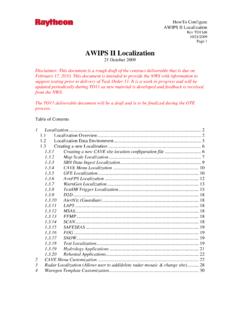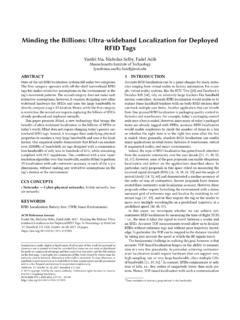Transcription of NIHSS & Localization
1 NIHSS & LocalizationLaurie Schluter, MSN, FNP, whereyou are testing with what you are hemisphere functionsRight hemisphere functionsanalyticalholisticverbalprosodi clogicalintuitivenumerical computation (exactcalculation, numerical comparison, estimation)numerical computation (approximatecalculation, numerical comparison, estimation)language: grammar/vocabulary, literallanguage: intonation/accentuation, prosody, pragmatic, contextualNational Institute of Health (NIH) stroke scale ( NIHSS ) OStandardized method to measure the level of impairment caused by a stroke OQuantitativeOSystematic OAllows for the objective comparison of efficacy across different stroke treatments and rehabilitation interventions ScoresO0 4 = mild stroke O5 15 = moderate stroke O15 20 = moderate-to-severe stroke O21 42 = severe strokeOA maximal score of 42 represents the most severe and devastating stroke.
2 O0-Do not assume No Stroke1aLevel of ConsciousnessO0 = alert, keenly responsiveO1 = not alert, but arousable by minor stimulation to obey, answer, or respondO2 = not alert, requires repeat stimulation to attend, or is obtunded and requires strong or painful stimulation to make movementsO3 = coma, responds only with reflex motor or autonomic effects or totally unresponsive, flaccid, and areflexicStrokes affecting LOCOR eticular activating systemOBasilar artery occlusionsOStrokes that affect the brainstemOBilateral cortical dysfunctionONew stroke to one hemisphere if old stroke to other hemisphereOStroke mimic-seizure, overdose, strokesOICP elevation or obstructive hydrocephalus1bLOC QuestionsOCurrent month of the yearOPatient s ageO0 = answers both questions correctlyO1 = answers one question correctlyO2 = answers neither question correctly(if intubated, automatically score a 1)Inability to answer orientation questionsOFrontal strokes affecting memory OAphasia-Broca or WernickeONon stroke issues such as underlying dementia or delirium1cLOC CommandsOOpen and close the eyesOMake a fist and then open the nonparetic handO0 = follows both commandsO1 = follows one commandO2 = follows neither commandUnable to follow commands?
3 OUnable to understand the instruction-Wernicke sOProfound inattention affecting ability to complete taskOUnable to execute the movementOMotor deficitOApraxia 2-Best gazeonly assess horizontal gazeO0 = normalO1 = partial gaze palsyOPatient is unable to move one or both eyes fully in both directionsOAble to overcome with oculocephalic maneuverO2 = forced gaze deviationOPatient has conjugate deviation of eyes in one directionOUnable to overcome with oculocephalic maneuverGaze effectsOMCA strokes. Eyes will go toward the stroke lesion therefore looking away from affected sideOPCA strokes. Preference due to a visual field cut or Wrong way gaze OWhen eyes are deviated to the same side that is weakOStrokes of midbrain or ponsOSeizure -eyes will go away from lesion3-Visual field testingO0 = normalO1 = partial visual field cutO2 = complete hemifield cutO3 = bilateral visual field cut or blind Ideally, one eye at a time (other covered) and counting fingers in each quadrant.
4 In nonaphasic patient, acceptable to have them point to fingers wiggling in each quadrant. In aphasic or stuporous patient, acceptable to elicit blink to threat in each quadrant with eyelids held open. If blind in one eye, only test sighted eyeStrokes affecting visual fieldsOMiddle Cerebral Artery (MCA)OPosterior Cerebral Artery (PCA)4-Facial paresisO0 = normal, symmetricalO1 = minor paralysis, nasolabial fold flattening, asymmetry of smileO2 = partial paralysis, total or near total paralysis of the lower faceO3 = total or near total paralysis of the upper and lower faceStrokes causing facial droop sparing the foreheadOPoorly localizingOCortical MCAOS ubcorticalMCAOS ubcorticalPCAOS ubcorticalbrainstem (basilar)OPontomedullary(generally get a nuclear palsy with involvement in forehead)
5 5-8 Motor functionO5 Right Arm Motor FunctionO6 Left Arm Motor FunctionOTest upper extremities for 10 secondsOAt 45 degrees supineO7 Right Leg Motor FunctionO8 Left Leg Motor FunctionOTest lower extremities for 5 secondsOAt 30 degrees supineMotor scoresO0 = no driftO1 = any driftO2 = some antigravity O3 = some movement, but not antigravityO4 = no movementOX = untestable, amputation, joint fusion or necessary restraint prevents testingStroke affecting motor functionOMCA-more commonly face and arm contralateralOACA-more commonly leg contralateralOSubcorticalOBasilar can cause quadriplegia or tetraplegia9-AtaxiaOTest finger-to-noseOTest heel-to-shinOTest with eyes openO0 = no ataxia, ataxia is scored only if out of proportion to the weaknessO1 = ataxia in one limbO2 = ataxia in two limbsOX = untestable, amputation, or joint fusionStroke causing ataxiaOCerebellarOPCAOB rainstem10-SensoryOTest pin prick-comparing left to right.
6 Test face, arms, legsODo not test the patient s handsO0 = normalO1 = partial (mild-to-moderate) sensory lossO2 = dense (severe or total) sensory lossStroke affecting sensationOMCAOACAOS ubcortical-Small vesselOCrossed sensory (face on one side and arm + leg on the opposite side) = highly localizing to the medulla (vertebral artery perforator)11-Best language/AphasiaOTest fluency, naming, repetition, comprehension, and reading (+/-writing)O0 = normalO1 = mild-to-moderateO2 = severeO3 = mute/globalOA mute patient who is able to follow commands scores a this picture-f luencyNaming objectsAsk patient to repeat wordsAsk to read the sentencesStrokes affecting languageOLeft MCAOLeft ACAOLeft PCA MCA mimic OMay also score points on language section due to confusion, inattentiveness, alteration in have trouble reading if visual field cut or visual neglect12-DysarthriaO0 = normalO1 = mild-to-moderate O2 = severe/unintelligibleOX = untestable (patient is intubated or other mechanical barrier)
7 OIf patient is mute, score 2 for dysarthriaAsk patient to repeat wordsStroke affecting quality of speechPoorly localizingOMCAOACAOB asilarOSubcortical13-NeglectO0 = noneO1 = partial (only neglect of one modality)O2 = complete (neglect of more than one modality)OTest for visual neglect and sensory neglect using double simultaneous stimulation OPatient may have hemibodyand motor neglectStroke causing neglectOAlmost always a right hemisphere phenomenonOMCA hemibodyneglect, hemisensoryneglect, hemiauditoryneglectOPCA hemisensoryneglect, visual field neglectOPatient may have no awareness of their deficits. As a result, may try to get up off of stretcher when paretic on one side. May have arm stuck through bed rail in unnatural position without awareness.
8 I fell down and couldn t get up, not understanding in Stroke-pts scoring 3 on item 1a (LOC)A patient suspected to be in coma should be stimulated by rubbing on the chest or by using a painful stimulus. A 3 on 1a should only be scored if the patient makes no movement (other than reflexive posturing) in response to the noxious stimuli. Pts who appear to be in coma & who score less than 3 must be tested on all NIHSS scoring a 3on Item 1a, the remaining items should be scored as: Item 1b(LOC questions)-Score 2 Item 2(best Gaze)-patient can be in coma & have gaze palsy that can be overcome by moving the head. Thus, the oculocephalic maneuver must be done & the patient scored. Item 3(Visual)-Test using bilateral threat Item 4(Facial Palsy)-Score 3 Items 5& 8-(Motor)-This item is interpreted as the voluntarily ability to attain a posture.
9 Score 4for all. Item 9(Limb ataxia)-Scored only if present, out of proportion to weakness. Otherwise, score 0. Item 10(Sensory)-Score 2 (arbitrary) Item 11 (Aphasia)-Score 3 Item 12(Dysarthria)-Score 2 whether intubated or not. Item 13(Extinction & Inattention)-Coma implies loss of all cognitive abilities. Score 2 NIHSS LimitationsOAffected by alertness, awareness and NIHSS is highly weighted toward deficits caused by anterior circulation strokes while deficits due to posterior circulation strokes receive fewer the anterior circulation, the scale underestimates the degree of right vs. left hemisphere performs unequally in the detection of stroke depending upon lesion location and it is, therefore, possible that some patients with persistent symptoms upon arrival to the emergency department (ED) and an NIHSS 0 still have an not captured by NIHSSOH eadacheONauseaODizzinessOTruncalAtaxiaOH and or foot weakness without proximal limb involvementOLoss of sensation to handOMemory lossOLoss of vision in one eye only (monocular)OLoss of vertical eye movementsOHoarsenessIn addition to NIHSSOP upillary examOAbnormal eye movementsOObserve quality of gait and ability to sit up straightOPresence of hiccupsOQuality of voice (hoarseness)
10 OStrength testing/ presence of tone vs flaccidityStroke SyndromesLeft MCAOU nable to answer questionsODue to aphasia OUnable to follow commandsODue to aphasiaOLeft gaze preferenceOLeft frontal lobe dysfunctionORight visual field deficitOLeft optic radiations damageORight sided hemiparesis(face/arm>leg)OLeft frontal cortex damageODiminished sensation of the right armOLeft parietal cortex damageOInability to name, repeat or readOLanguage center dysfunctionNIHSS 221a -LOC0 -Alert 1 -Drowsy 2 -Stupor 3 -Comatose1b -LOC0 -Both 1 -One 2 -Neither1c -LOC Commands0 -Both 1 -One 2 -Neither2 -Best Gaze0 -NL 1 -Partial 2 -Forced Gaze3 -Visual Fields0 -NL 1 -Partial 2 -Complete 3 -Bilateral4 -Facial Paresis0 -NL 1 -Minor 2 -Partial 3 -Complete5 -8 MotorKey____4_____5 -Right Arm0 -No Drift____0_____ 6 -Left Arm1 -Drift____3_____ 7 -Right Leg2 -Some Effort vs.










